A Study on the Effect of Process and Material Variables on the Hot Stamping Formability of Automotive Body Parts
Abstract
1. Introduction
2. Effect of Process and Material Variables on Hot Stamping Formability Estimated by T-Type Part Forming Test
3. Effect of Process and Material Variables on Hot Stamping Formability Estimated by B-Pillar Part Forming Analysis
4. Evaluation of the Effect of Process and Material Variables Based on Hot Stamping Forming Analysis
4.1. Variable 1: Effect of the Initial Temperature of the Sheet Blank
4.2. Variable 2: Effect of Sheet Thickness
4.3. Variable 3: Effect of Friction Coefficient
4.4. Variable 4: Effect of Strain-Rate Sensitivity
4.5. Summary
5. Conclusions
- (1)
- T-type forming was performed by changing the initial temperature and initial thickness of the sheet blank. As a result, the higher the initial temperature of the sheet blank and the larger the initial thickness of the sheet blank, the fracture occurred at a greater depth of drawing. That is, as the initial temperature and initial thickness of the sheet blank increased, the forming limit of the sheet blank increased.
- (2)
- The hot stamping analysis of B-pillar parts was performed by changing four processes and material variables: the initial temperature of the sheet blank, the initial thickness of the sheet blank, the die-blank friction coefficient, and the strain-rate sensitivity of the material. As a result, the effect of the variable on the thickness strain of the formed part was in the order of the die-blank friction coefficient, the strain-rate sensitivity of the material, the initial sheet blank temperature, and the initial sheet blank thickness. Additionally, the effect of the variable on the martensite phase ratio of the formed part was in the order of the initial temperature of the sheet blank, the initial thickness of the sheet blank, the strain-rate sensitivity of the material, and the die-blank friction coefficient.
- (3)
- Formability in this study is a concept that includes both the thickness strain and the martensite phase ratio of the formed part. Among them, in terms of thickness strain, the formability is excellent when the forming limit is high and fracture does not easily occur. Additionally, in terms of the martensite phase ratio, the formability is excellent when the strength of the formed part increases due to sufficient phase transformation into martensite during the stamping process. If the formability of a product is not sufficiently excellent under the conditions of a given process and material variable, it will be possible to improve the formability by changing the variable as much as necessary based on the sensitivity of formability to process and material variables. In the case of material variables, the strain-rate sensitivity of material may be altered by changing the alloy composition of the original material or by changing the grain size through appropriate plastic working.
Author Contributions
Funding
Institutional Review Board Statement
Informed Consent Statement
Data Availability Statement
Acknowledgments
Conflicts of Interest
References
- Mori, K.; Maki, S.; Tanaka, Y. Warm and hot stamping of ultra high tensile strength steel sheets using resistance heating. CIRP Ann. 2005, 54, 209–212. [Google Scholar] [CrossRef]
- Merklein, M.; Lechler, J.; Geiger, M. Characterization of the flow properties of the quenchenable ultra high strength steel 22MnB5. CIRP Ann. 2006, 55, 229–232. [Google Scholar] [CrossRef]
- Bariani, P.F.; Bruschi, S.; Ghiotti, A.; Turetta, A. Testing formability in the hot stamping of HSS. CIRP Ann. 2008, 57, 265–268. [Google Scholar] [CrossRef]
- Karbasian, H.; Tekkaya, A.E. A review on hot stamping. J. Mater. Process. Technol. 2010, 210, 2103–2118. [Google Scholar] [CrossRef]
- Abdulhay, B.; Bourouga, B.; Dessain, C. Experimental and theoretical study of thermal aspects of the hot stamping process. Appl. Therm. Eng. 2011, 31, 674–685. [Google Scholar] [CrossRef]
- Turetta, A.; Bruschi, S.; Ghiotti, A. Investigation of 22MnB5 formability in hot stamping operations. J. Mater. Process. Technol. 2006, 177, 396–400. [Google Scholar] [CrossRef]
- Shao, Z.; Li, N.; Lin, J.; Dean, T. Formability evaluation for sheet metals under hot stamping conditions by a novel biaxial testing system and a new materials model. Int. J. Mech. Sci. 2017, 120, 149–158. [Google Scholar] [CrossRef]
- Dahan, Y.; Chastel, Y.; Duroux, P.; Hein, P.; Massoni, E.; Wilsius, J. Formability investigations for the hot stamping process. In Proceedings of the International Deep Drawing Research Group (IDDRG) International Conference, Porto, Portugal, 19–21 June 2006. [Google Scholar]
- Kusumi, K.; Maki, J.; Nomura, N. Formability and FEM simulation of steel sheets in the hot stamping process. Nippon Steel Tech. Rep. 2013, 103, 47–54. [Google Scholar]
- Windmann, M.; Röttger, A.; Theisen, W. Formation of intermetallic phases in Al-coated hot-stamped 22MnB5 sheets in terms of coating thickness and Si content. Surf. Coat. Technol. 2014, 246, 17–25. [Google Scholar] [CrossRef]
- Gorriño, A.; Angulo, C.; Muro, M.; Izaga, J. Investigation of Thermal and Mechanical Properties of Quenchable High-Strength Steels in Hot Stamping. Metall. Mater. Trans. B 2016, 47, 1527–1531. [Google Scholar] [CrossRef]
- Gui, Z.X.; Liang, W.K.; Liu, Y.; Zhang, Y.S. Thermo-mechanical behavior of the Al–Si alloy coated hot stamping boron steel. Mater. Des. 2014, 60, 26–33. [Google Scholar] [CrossRef]
- Kim, H.K.; Lee, S.H.; Choi, H. Evaluation of Contact Heat Transfer Coefficient and Phase Transformation during Hot Stamping of a Hat-Type Part. Materials 2015, 8, 2030–2042. [Google Scholar] [CrossRef]
- Dilmec, M.; Halkaci, H.S.; Ozturk, F. Effects of sheet thickness and anisotropy on forming limit curves of AA2024-T4. Int. J. Adv. Manuf. Technol. 2013, 67, 2689–2700. [Google Scholar] [CrossRef]
- Li, H.; Wu, X.; Li, G. Prediction of Forming Limit Diagrams for 22MnB5 in Hot Stamping Process. J. Mater. Eng. Perform. 2013, 22, 2131–2140. [Google Scholar] [CrossRef]
- Li, F.F.; Fu, M.W.; Lin, J.P. Experimental and theoretical study on the hot forming limit of 22MnB5 steel. Int. J. Adv. Manuf. Technol. 2014, 71, 297–306. [Google Scholar] [CrossRef]
- Yao, D.; Cai, L.; Bao, C. A new fracture criterion for ductile materials based on a finite element aided testing method. Mater. Sci. Eng. A 2016, 673, 633–647. [Google Scholar] [CrossRef]
- Churyumov, A.Y.; Medvedeva, S.V.; Mamzurina, O.I.; Kazakova, A.A.; Churyumova, T.A. United Approach to Modelling of the Hot Deformation Behavior, Fracture, and Microstructure Evolution of Austenitic Stainless AISI 316Ti Steel. Appl. Sci. 2021, 11, 3204. [Google Scholar] [CrossRef]
- Kubík, P.; Šebek, F.; Hůlka, J.; Petruška, J. Calibration of ductile fracture criteria at negative stress triaxiality. Int. J. Mech. Sci. 2016, 108–109, 90–103. [Google Scholar] [CrossRef]
- Kim, H.K.; Kim, W.J. Failure prediction of magnesium alloy sheets deforming at warm temperatures using the Zener-Holloman parameter. Mech. Mater. 2010, 42, 293–303. [Google Scholar] [CrossRef]
- Jeon, Y.J.; Song, M.J.; Kim, H.K.; Cha, B.S. Effect of hot-stamping process conditions on the changes in material strength. Int. J. Automot. Technol. 2015, 16, 619–627. [Google Scholar] [CrossRef]
- Kusumi, K.; Nomura, N.; Yamamoto, S.; Nakata, M.; Abe, M.; Suehiro, M. Improvement of Cylindrical Deep Drawability in Hot Stamping. Procedia Eng. 2014, 81, 1719–1724. [Google Scholar] [CrossRef][Green Version]
- Marciniak, Z.; Duncan, J.L.; Hu, S.J. Mechanics of Sheet Metal Forming; Butterworth-Heinemann: Oxford, UK, 2002; p. 75. [Google Scholar]
- Llewellyn, D.; Hudd, R. Steels: Metallurgy and Applications, 3rd ed.; Butterworth-Heinemann: Oxford, UK, 1998; p. 28. [Google Scholar]
- Dahan, Y.; Chastel, Y.; Duroux, P.; Wilsius, J.; Hein, P. Procedure for the Experimental Determination of a Forming Limit Curve for Usibor 1500 P. In Proceedings of the International Deep Drawing Research Group (IDDRG) International Conference, Györ, Hungary, 21–23 May 2007. [Google Scholar]
- Cao, J.; Yao, H.; Karafillis, A.; Boyce, M.C. Prediction of localized thinning in sheet metal using a general anisotropic yield criterion. Int. J. Plast. 2000, 16, 1105–1129. [Google Scholar] [CrossRef]
- Sarkar, B.; Jha, B.K.; Mukerjee, D.; Jha, S.; Narasimhan, K. Thinning as a failure criterion during sheet metal forming. Pract. Fail. Anal. 2002, 2, 63–64. [Google Scholar] [CrossRef]
- Zhang, C.; Leotoing, L.; Guines, D.; Ragneau, E. Theoretical and numerical study of strain rate influence on AA5083 formability. J. Mater. Process. Technol. 2009, 209, 3849–3858. [Google Scholar] [CrossRef]
- Khan, A.S.; Baig, M. Anisotropic responses, constitutive modeling and the effects of strain-rate and temperature on the formability of an aluminum alloy. Int. J. Plast. 2011, 27, 522–538. [Google Scholar] [CrossRef]
- Romhanji, E.; Dudukovska, M.; Glišić, D. The effect of temperature on strain-rate sensitivity in high strength Al–Mg alloy sheet. J. Mater. Process. Technol. 2002, 125–126, 193–198. [Google Scholar] [CrossRef]
- Simon, P.; Demarty, Y.; Rusinek, A.; Voyiadjis, G.Z. Material Behavior Description for a Large Range of Strain Rates from Low to High Temperatures: Application to High Strength Steel. Metals 2018, 8, 795. [Google Scholar] [CrossRef]
- Tomáš, M.; Evin, E.; Kepič, J.; Hudák, J. Physical Modelling and Numerical Simulation of the Deep Drawing Process of a Box-Shaped Product Focused on Material Limits Determination. Metals 2019, 9, 1058. [Google Scholar] [CrossRef]
- Vrolijk, M.; Lorenz, D.; Porzner, H.; Holecek, M. Supporting lightweight design: Virtual modeling of hot stamping with tailored properties and warm and hot formed aluminium. Procedia Eng. 2017, 183, 336–342. [Google Scholar] [CrossRef]
- Hora, P.; Volk, W.; Roll, K.; Griesbach, B.; Kessler, L.; Hotz, W. The Numisheet 2008 Benchmark Study Part B; Numisheet 2008 Organizing Committee: ETH Zurich, Switzerland, 2008; pp. 115–129. [Google Scholar]
- Bosetti, P.; Bruschi, S.; Stoehr, T.; Lechler, J.; Merklein, M. Interlaboratory comparison for heat transfer coefficient identification in hot stamping of high strength steels. Int. J. Mater. Form. 2010, 3, 817–820. [Google Scholar] [CrossRef]
- Liu, X.; Gharbi, M.M.; Manassib, O.; Fakir, O.E.; Wang, L. Determination of the interfacial heat transfer coefficient between AA7075 and different forming tools in hot stamping processes. Procedia Eng. 2017, 207, 717–722. [Google Scholar] [CrossRef]
- Zhang, P.; Zhu, L.; Xi, C.; Luo, J. Study on Phase Transformation in Hot Stamping Process of USIBOR® 1500 High-Strength Steel. Metals 2019, 9, 1119. [Google Scholar] [CrossRef]
- Naderi, M.; Bleck, W. An investigation into martensitic transformation in hot stamping process. Wit. Trans. Eng. Sci. 2007, 57, 95–104. [Google Scholar]
- Yanagida, A.; Azushima, A. Evaluation of coefficients of friction in hot stamping by hot flat drawing test. CIRP Ann. 2009, 58, 247–250. [Google Scholar] [CrossRef]
- Sasaki, H.; Mukai, T.; Yanagida, A. Measurement of coefficient of friction in hot stamping by hot deep drawing test. Key Eng. Mat. 2016, 716, 184–189. [Google Scholar] [CrossRef]
- Uda, K.; Azushima, A. Effect of Die Surface Coating on Coefficient of Friction in Hot Stamping of Aluminum-coated High-Strength Steel. J. Jpn. Soc. Technol. Plast. 2014, 55, 132–136. [Google Scholar] [CrossRef][Green Version]
- Geiger, M.; Merklein, M.; Lechler, J. Determination of tribological conditions within hot stamping. Prod. Eng. 2008, 2, 269–276. [Google Scholar] [CrossRef]
- Li, G.; Long, X.; Yang, P.; Liang, Z. Advance on friction of stamping forming. Int. J. Adv. Manuf. Technol. 2018, 96, 21–38. [Google Scholar] [CrossRef]
- Pelcastre, L. Hot Forming Tribology: Galling of Tools and Associated Problems. Licentiate Thesis, Luleå University of Technology, Luleå, Sweden, 2011. [Google Scholar]
- Hosford, W.F.; Caddell, R.M. Metal Forming: Mechanics and Metallurgy, 3rd ed.; Cambridge University Press: Cambridge, UK, 2007; pp. 52–72. [Google Scholar]
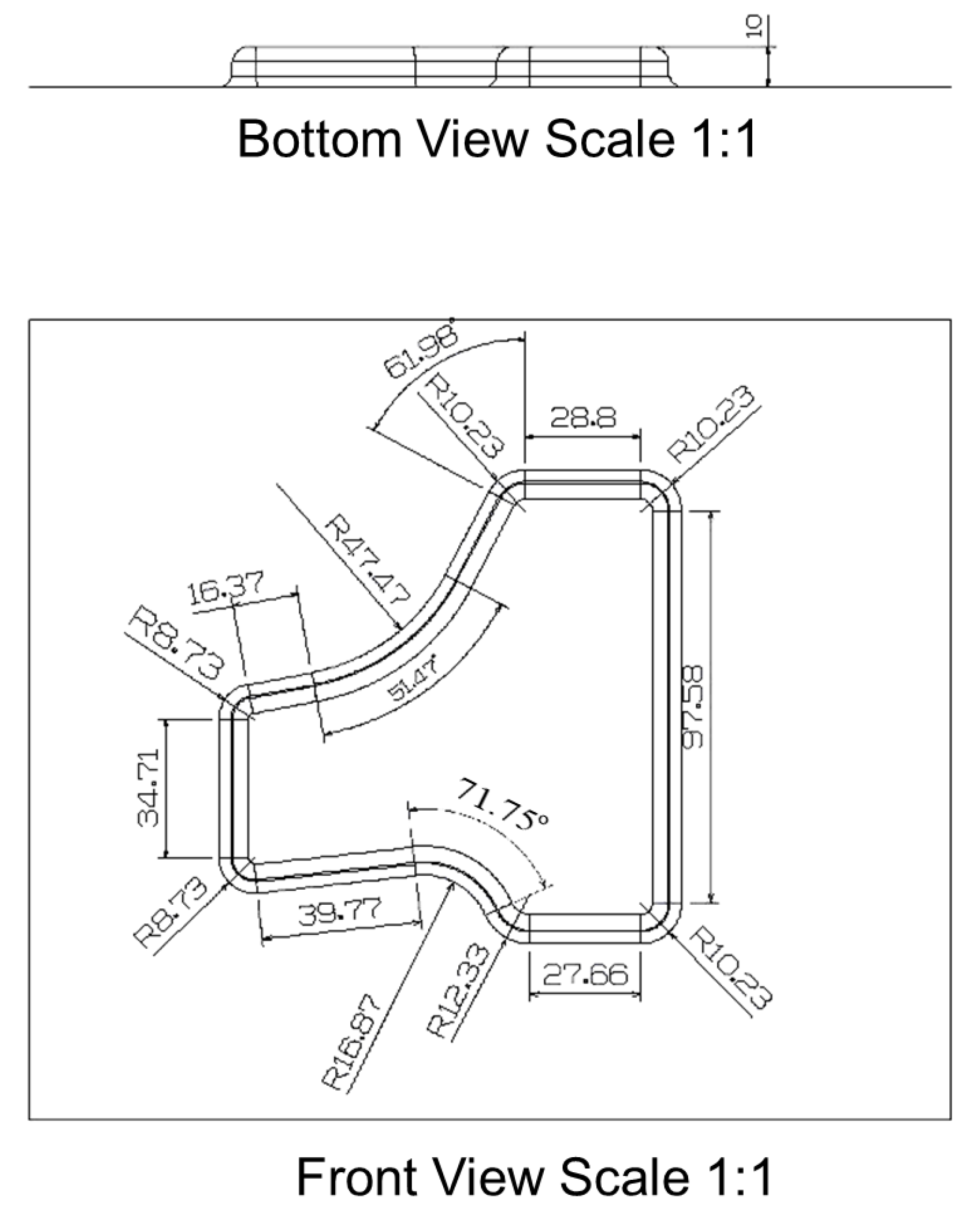
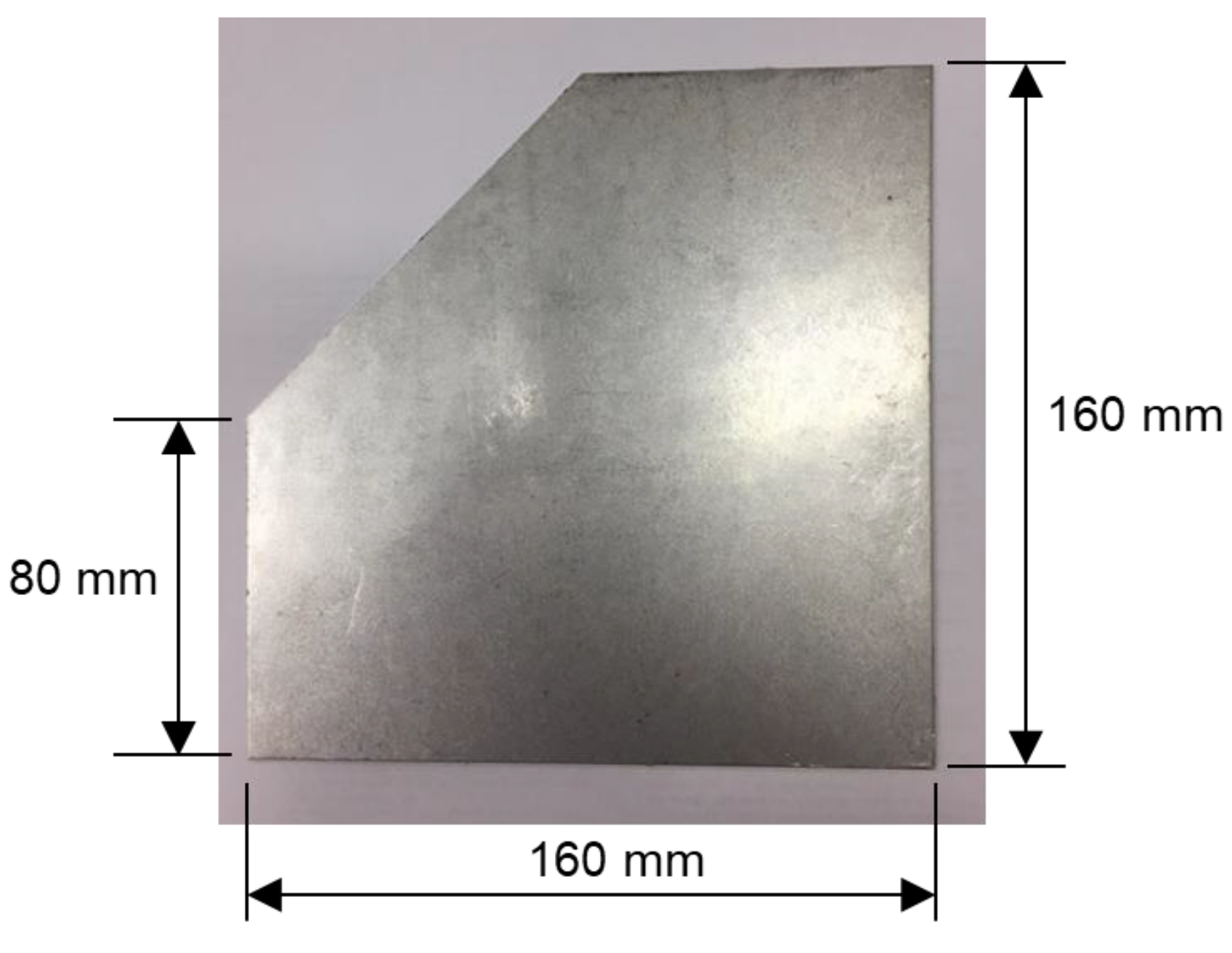

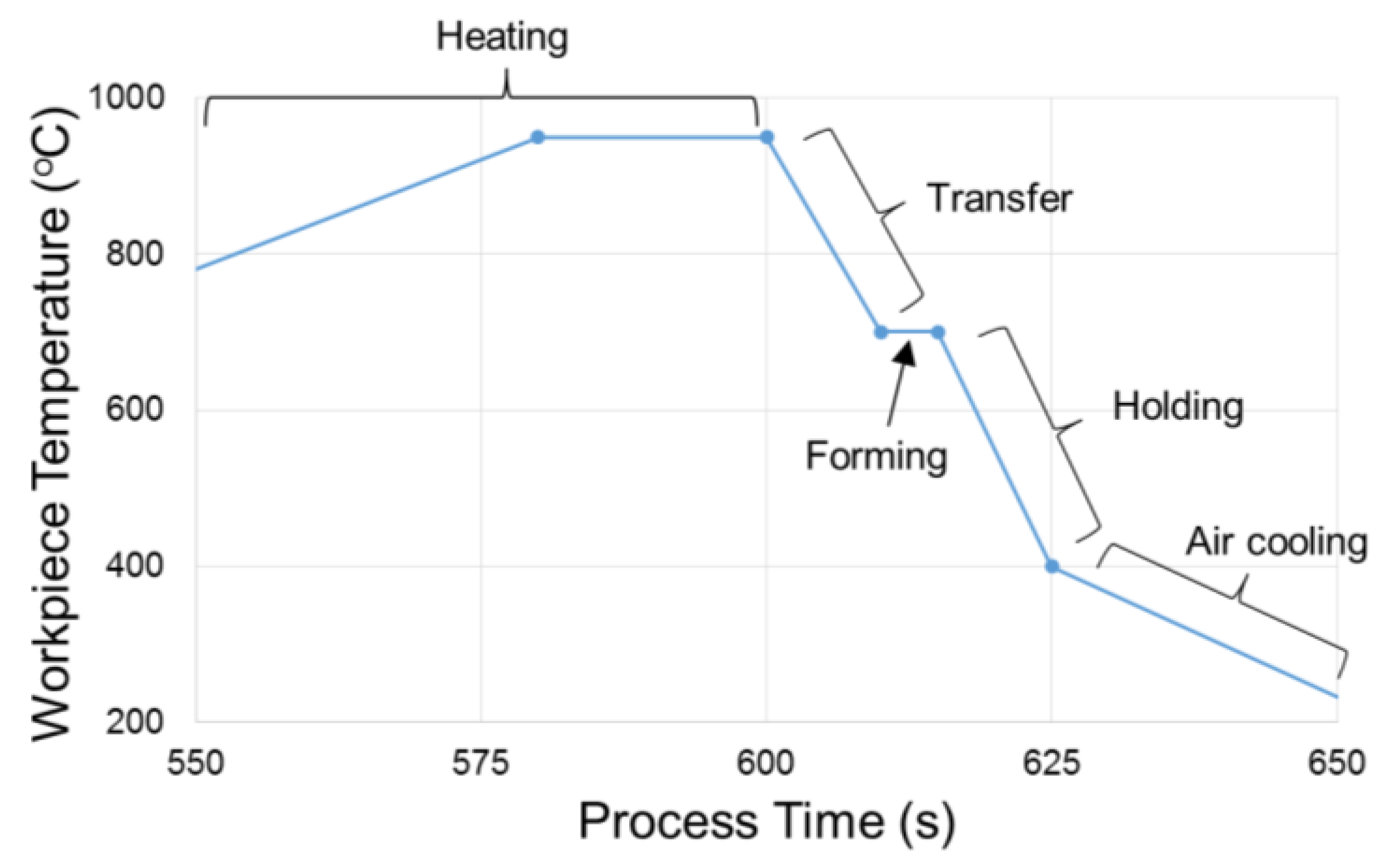


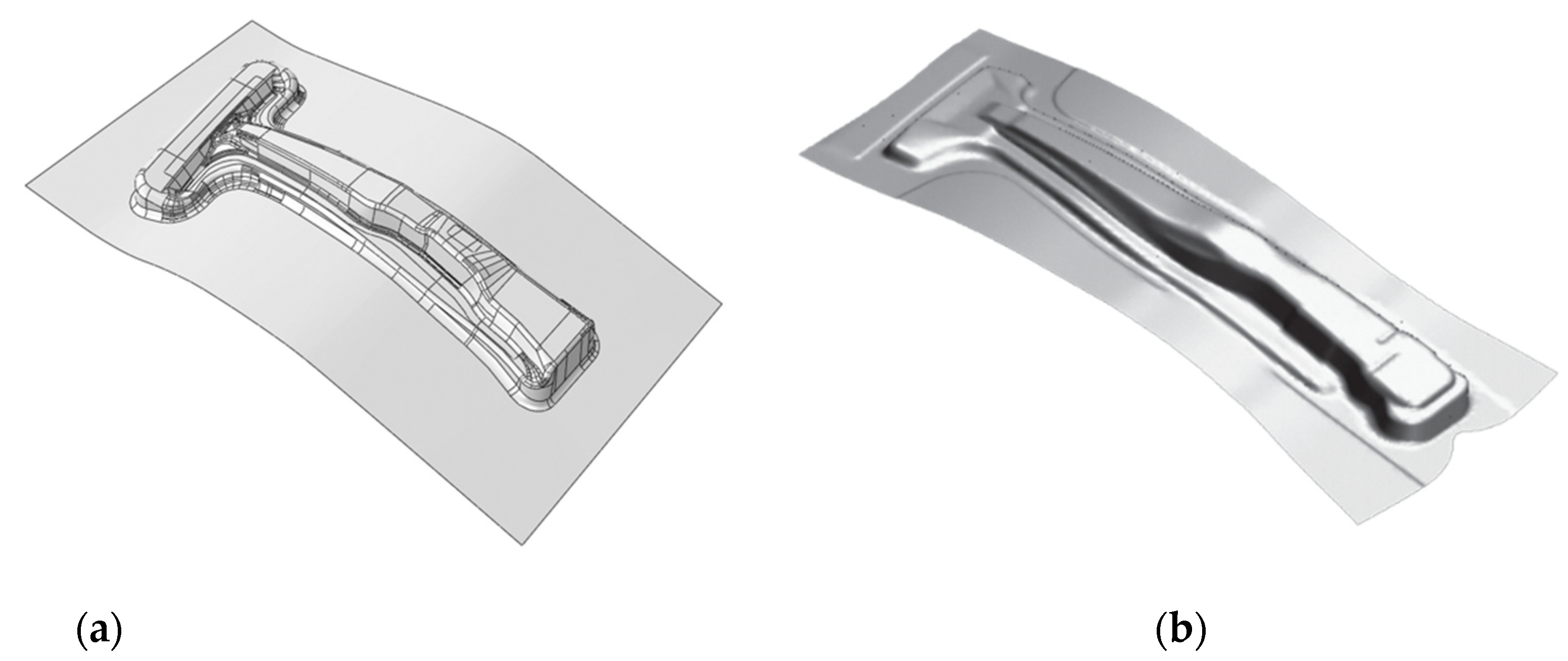

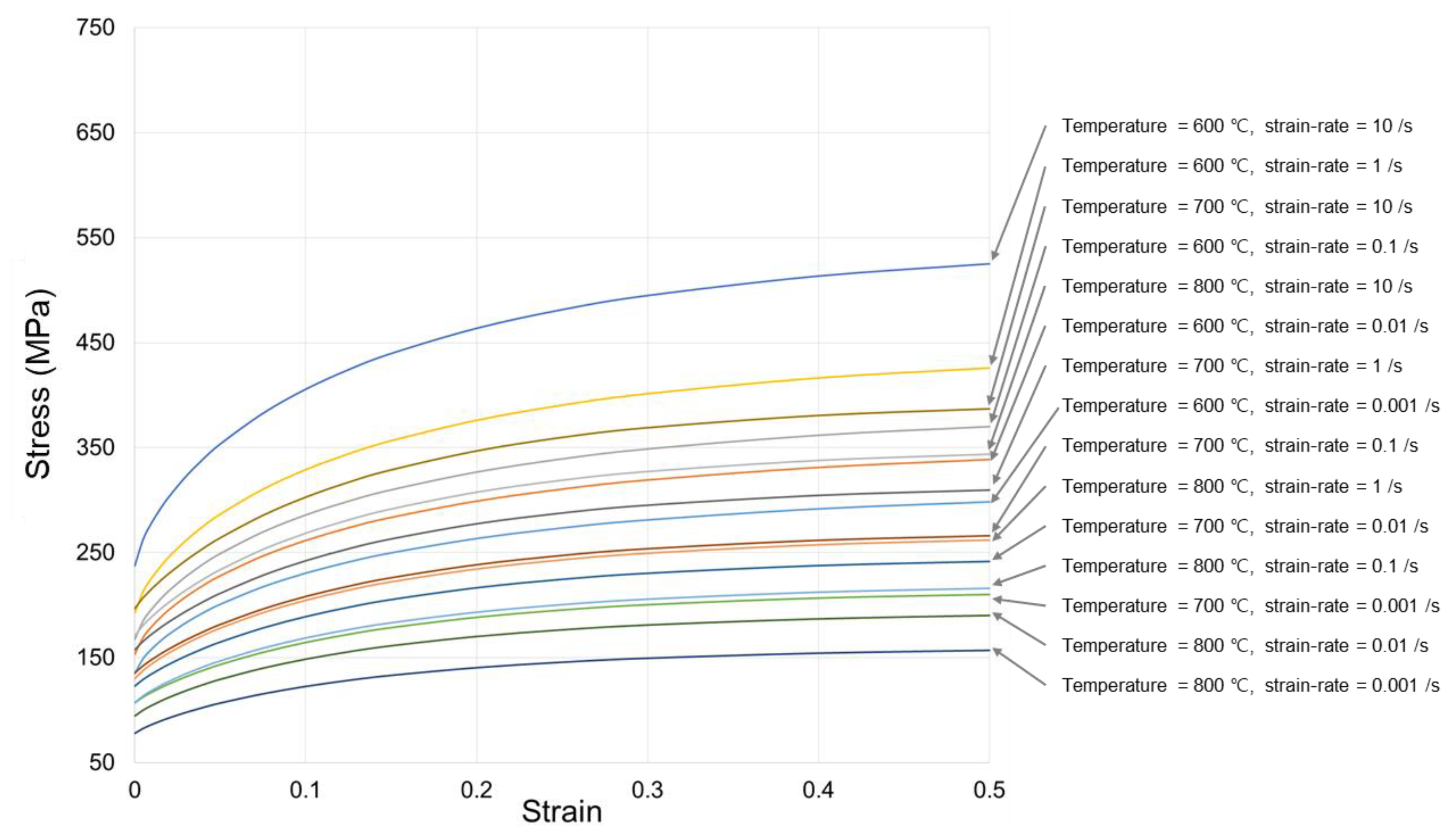
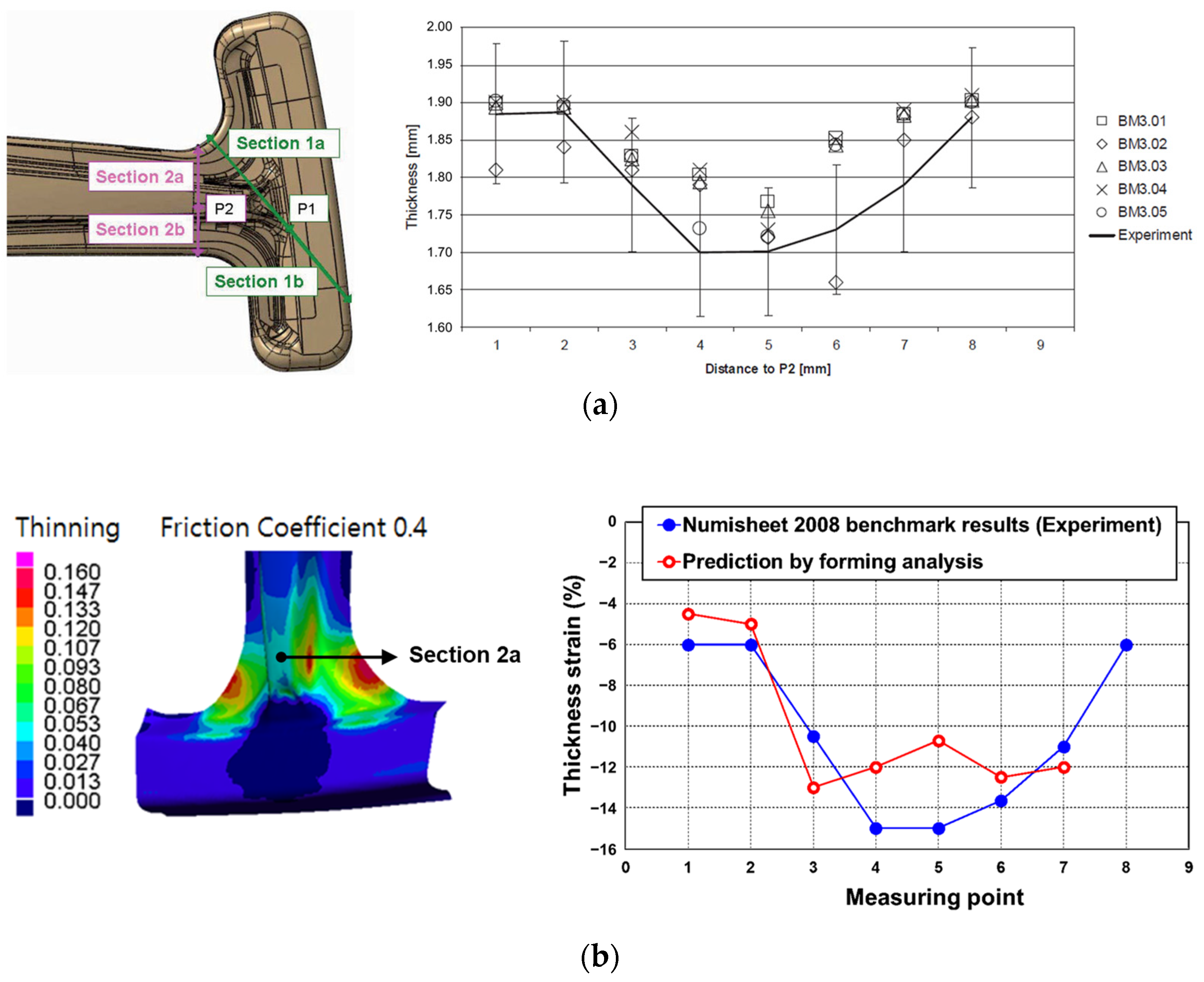
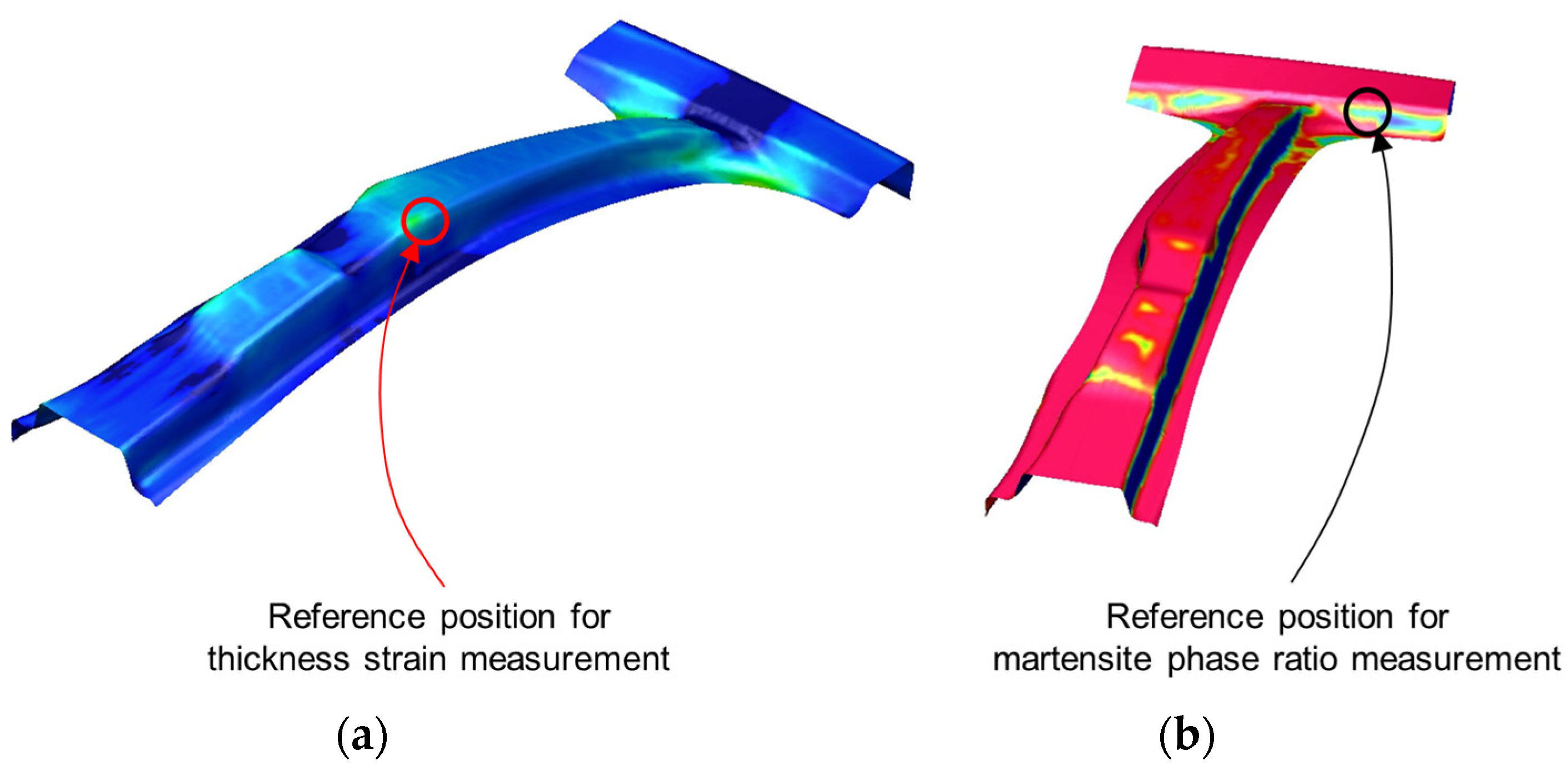
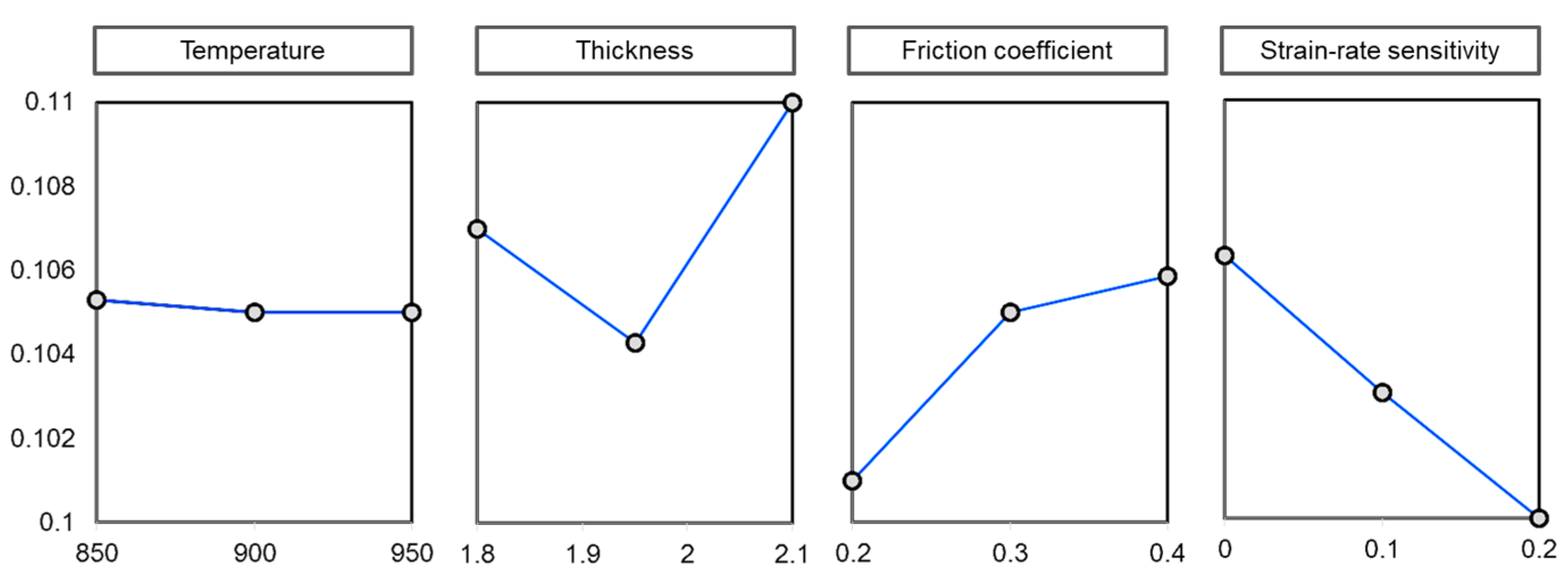
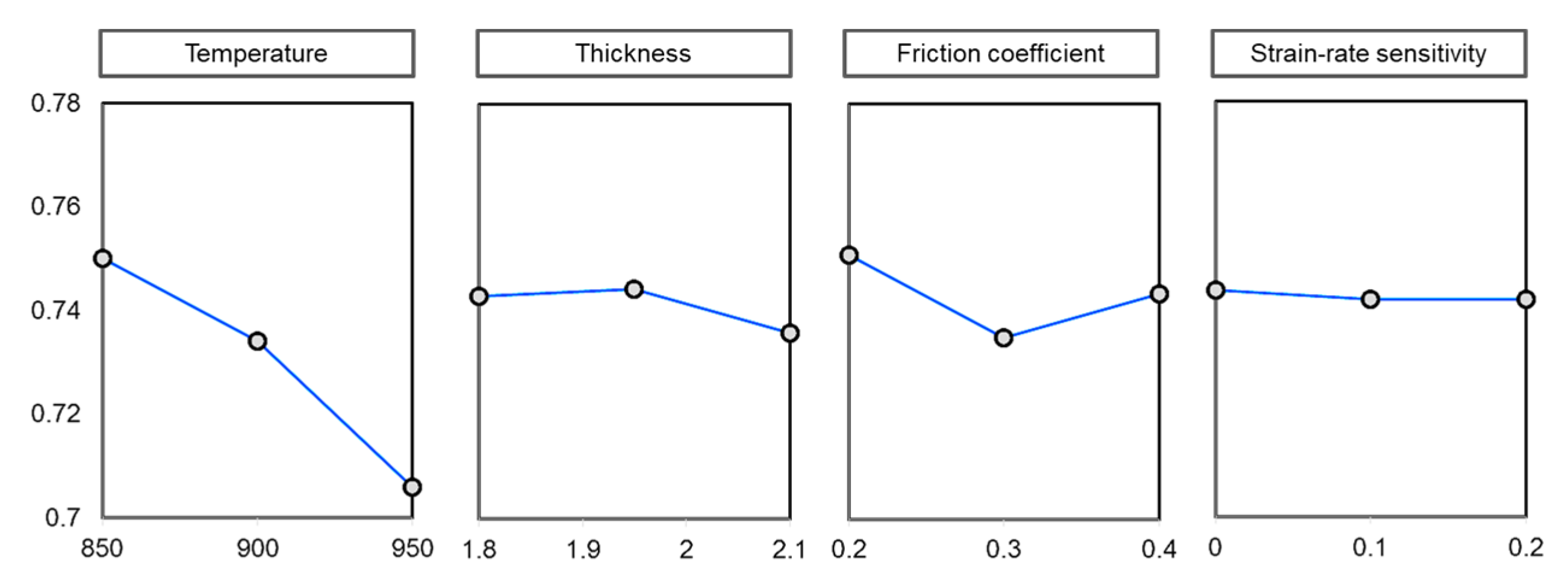

| Composition (wt.%) | ||||||
|---|---|---|---|---|---|---|
| C | Si | Mn | P | S | B | Fe |
| 0.23 | 0.26 | 1.24 | 0.015 | 0.002 | 0.0023 | Balanced |
| Case | Thickness (mm) | Temperature (°C) | Drawing Depth (mm) | Formability |
|---|---|---|---|---|
| 1 | 1 | 900 | 10 | Crack |
| 2 | 1 | 950 | 10 | No defect |
| 3 | 1 | 950 | 12 | Crack, Fracture |
| 4 | 1 | 950 | 13 | Fracture |
| 5 | 1 | 950 | 14 | Fracture |
| 6 | 1.2 | 950 | 14 | Neck |
| 7 | 1 | 1000 | 10 | No defect |
| 8 | 1.2 | 1000 | 14 | No defect |
| 9 | 1.2 | 1000 | 15 | Fracture |
| Fixed Values of Process and Material Variables | Unit | Value of Variable |
|---|---|---|
| Initial temperature of die | °C | 70 |
| Temperature of cooling water | °C | 12 |
| Temperature of air | °C | 20 |
| Convection heat transfer coefficient | kW/m2K | 0.01 |
| Press speed | mm/s | 250 |
| Time for quenching | s | 30 |
| Punch-die clearance | mm | 1.2 |
| Die pad force | MN | 0.8 |
| Holder force | MN | 0.15 |
| Process and Material Variable | Unit | Values Applied to Forming Analysis |
|---|---|---|
| Initial thickness of sheet | mm | 1.8, 1.95, 2.1 |
| Initial temperature of sheet | °C | 850, 900, 950 |
| Friction coefficient | - | 0.2, 0.3, 0.4 |
| 1/s | 0, 0.1, 0.2 |
Publisher’s Note: MDPI stays neutral with regard to jurisdictional claims in published maps and institutional affiliations. |
© 2021 by the authors. Licensee MDPI, Basel, Switzerland. This article is an open access article distributed under the terms and conditions of the Creative Commons Attribution (CC BY) license (https://creativecommons.org/licenses/by/4.0/).
Share and Cite
You, K.H.; Kim, H.-K. A Study on the Effect of Process and Material Variables on the Hot Stamping Formability of Automotive Body Parts. Metals 2021, 11, 1029. https://doi.org/10.3390/met11071029
You KH, Kim H-K. A Study on the Effect of Process and Material Variables on the Hot Stamping Formability of Automotive Body Parts. Metals. 2021; 11(7):1029. https://doi.org/10.3390/met11071029
Chicago/Turabian StyleYou, Kang Ho, and Heung-Kyu Kim. 2021. "A Study on the Effect of Process and Material Variables on the Hot Stamping Formability of Automotive Body Parts" Metals 11, no. 7: 1029. https://doi.org/10.3390/met11071029
APA StyleYou, K. H., & Kim, H.-K. (2021). A Study on the Effect of Process and Material Variables on the Hot Stamping Formability of Automotive Body Parts. Metals, 11(7), 1029. https://doi.org/10.3390/met11071029






